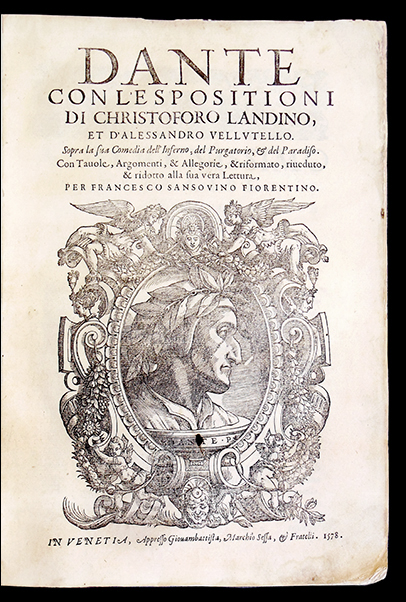"Follow your own star!" Dante in Special Collections
 Dante’s Divine Comedy was the runaway hit of medieval and Renaissance Italy. More than 600 manuscript copies of the poem were made within eighty years of Dante’s death in 1321, and after the invention of printing in the mid fifteenth century, publishers would issue dozens of editions of his work.
Dante’s Divine Comedy was the runaway hit of medieval and Renaissance Italy. More than 600 manuscript copies of the poem were made within eighty years of Dante’s death in 1321, and after the invention of printing in the mid fifteenth century, publishers would issue dozens of editions of his work.
Special Collections recently acquired one of those editions for the Rare Book Collection, which already holds many landmarks of Western literature and philosophy.
Published in 1578, it is a valuable tool for teaching and studying not only the Divine Comedy itself, but also religion, philosophy, Italian political and cultural history, the rise of vernacular languages, and the history of scholarly editing, one of the driving forces behind the flowering of knowledge that we now call the Renaissance.
In 1472, Johann Neumeister, a German printer working in Italy, issued the first printed edition of Dante. The earliest edition with commentary appeared five years later. In 1502, the pioneering Venetian publisher Aldus Manutius went in the opposite direction by stripping away editorial commentary altogether and allowing readers to interpret Dante for themselves.
Nevertheless, editions with commentary remained the norm. They can now help scholars study, and students learn about, how texts were packaged, shaped, and interpreted over time. In other words, how is knowledge passed down to us? What have editors changed or omitted? Were they unbiased? What was the experience of reading Dante like during the Renaissance?
The main issue for Dante's first editors was spelling and word choice. Until relatively recently, there was no standard form of Italian, and even today, dialects survive. Five hundred years ago, editors argued over whether to “update” Dante’s fourteenth-century language (in the Tuscan dialect, the predecessor of modern Italian), or preserve its original character. (In England, the same thing happened with Geoffrey Chaucer’s works, several early editions of which are available in Special Collections.)
The edition of Dante recently acquired by the library also teaches us something about how Dante was politicized. Its multiple commentaries (or “expositions”) include one by the humanist scholar Cristoforo Landino (1424-98), tutor of Florence’s powerful ruler Lorenzo de’ Medici. Although Dante was widely read throughout Italy, the patriotic Landino made sure everyone knew he was a Florentine. Additionally, in an introduction, Francesco Sansovino (1521-86) added the names of Michelangelo and Leonardo da Vinci to Landino’s list of Florence’s cultural superstars.
Also significant is a commentary by Alessandro Vellutello (born 1473) which put Dante in historical context and provided information about his sources—information that might otherwise have been lost. Our understanding of the poem is helped along even further by a glossary of difficult and outdated words (again paralleling early editions of Chaucer).
What really stands out are the edition’s illustrations. Designed to complement Vellutello’s commentary, most of them show Dante’s Inferno, Purgatory, and Paradise from a bird’s-eye view, an innovative feature that distinguishes them from illustrations found in manuscripts and earlier printed editions.
Interested in seeing other editions of Dante? Here are a few from our collections to get you started...
- Il Codice Trivulziano 1080. Facsimile of a manuscript of the Divine Comedy, dated 1337.
- Codex Altonensis. Late 14th- or early 15th-century manuscript of the Divine Comedy.
- Dante con nuove et utili ispositioni (1571). Pocket edition of the Divine Comedy.
- Rime di diversi antichi autori toscani (1532). Anthology of works by Tuscan poets, including Dante.
- La vita nuova di Dante (1902), with a medieval-inspired transparent vellum (“vellucent”) binding by Cedric Chivers of Bath.
Codex Altonensis (facsimile)" data-title="Codex Altonensis (facsimile)"">
La vita nuova di Dante (1902)" data-title="La vita nuova di Dante (1902)"">
